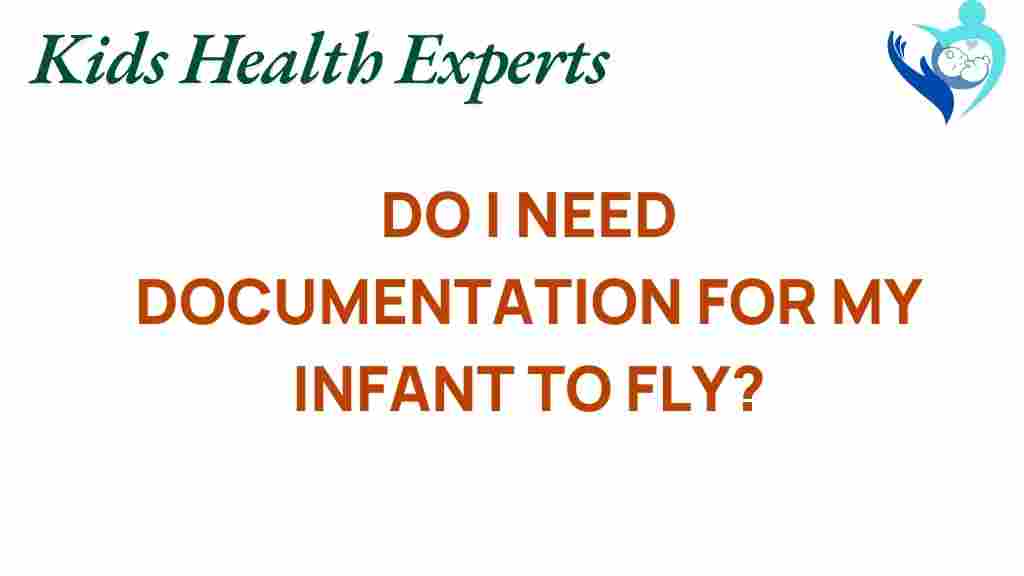Do Infants Need Documentation to Fly? What Parents Must Know About Infant Travel
Traveling with your little one can be an exciting adventure, but it often comes with a multitude of questions and concerns, especially regarding infant travel. One of the most pressing questions for parents is whether their infants need any travel documentation to fly. Understanding flying with babies involves knowing the travel documentation required, as well as the airline policies that can vary significantly from one airline to another. In this guide, we will cover everything parents must know about traveling with infants, ensuring you’re well-prepared for your journey.
Understanding Airline Policies for Infant Travel
When planning your trip, the first step is to check the airline policies regarding infant travel. Each airline may have different rules regarding age restrictions, seating arrangements, and necessary documentation.
- Age Requirements: Most airlines allow infants to travel from the age of two days old, but some may require a minimum age of two weeks.
- Seating: Infants under two years old can often fly as a lap child, meaning they do not need their own seat. However, if you prefer to have a separate seat for your infant, you will need to purchase a ticket.
- Documentation: This is where it gets tricky. Some airlines may require proof of age, such as a birth certificate, while others might not have strict documentation requirements.
Travel Documentation for Flying with Babies
Documentation requirements can vary widely, so it’s important to do your homework well in advance. Here are the key types of travel documentation you may need when flying with infants:
- Birth Certificate: Many airlines request a copy of your child’s birth certificate to verify their age, especially if they are traveling as a lap child.
- Infant Passport: If you are traveling internationally, your infant will need a passport. Obtaining an infant passport involves filling out a specific application and providing photos of your child.
- Visa: Depending on your destination, your infant may require a visa, which should be arranged ahead of time.
Step-by-Step Process for Preparing for Infant Travel
Here’s a comprehensive step-by-step guide to help you navigate the preparation for flying with babies:
Step 1: Check Airline Policies
Before booking your flight, research various airlines to find the best fit for your travel plans. Pay close attention to their policies regarding infant travel, including documentation requirements.
Step 2: Gather Necessary Documentation
Once you decide on an airline, gather all necessary documentation. This might include:
- Birth certificate for proof of age
- Infant passport if traveling internationally
- Any required visa documents
Step 3: Book Your Flight
When booking your flight, ensure you select the correct number of passengers, including your infant. If you want a separate seat for your baby, make sure to reserve it in advance.
Step 4: Prepare for Security Checks
Arrive at the airport early to allow enough time for security checks. Be prepared to present your infant’s documentation and follow any extra screening procedures for your baby’s belongings.
Step 5: Pack Essentials for the Flight
When packing, include all the essentials your baby will need during the flight:
- Diapers and wipes
- Extra clothes
- Formula or breast milk (check airline regulations on liquids)
- Pacifiers or bottles to help with ear pressure during takeoff and landing
- Favorite toys or blankets for comfort
Travel Tips for Flying with Infants
To ensure a smooth travel experience, consider the following travel tips:
- Choose flight times wisely: If possible, book flights during your baby’s nap time to encourage them to sleep during the journey.
- Arrive early: Allow extra time at the airport to handle any unforeseen issues related to documentation or security.
- Dress comfortably: Make sure your baby is dressed in comfortable clothing that is easy to change if necessary.
- Bring a stroller or carrier: This can help you navigate the airport easily and keep your baby secure.
- Stay calm: Babies can pick up on stress, so maintaining a calm demeanor can help soothe your infant during the flight.
Troubleshooting Tips for Common Issues
Even with the best planning, issues can arise. Here are some troubleshooting tips to help you manage common problems when flying with infants:
Problem: Baby Won’t Stop Crying
It’s common for infants to feel unsettled during flights. Here’s what you can do:
- Try feeding your baby during takeoff and landing to help relieve ear pressure.
- Engage them with toys or your voice to distract them.
- Walk up and down the aisle with your baby if it’s safe to do so.
Problem: Diaper Change Challenges
Changing diapers in an airplane bathroom can be tricky. To mitigate this:
- Bring a portable changing pad for a clean surface.
- Use the changing table in the bathroom if available, but be prepared for tight spaces.
- Change your baby’s diaper before boarding if possible.
Problem: Delays and Layovers
Traveling with an infant can be especially challenging during delays. Here are some tips:
- Keep a supply of snacks and toys handy to keep your baby occupied.
- Look for family lounges at the airport where you can have some space and comfort.
- Stay updated on flight changes through your airline’s app.
Conclusion: Be Prepared for a Stress-Free Journey
Traveling with infants doesn’t have to be a daunting task. By understanding flying regulations and preparing in advance, you can ensure a smoother and more enjoyable experience for both you and your baby. Always check the specific airline policies regarding infant travel and gather the necessary travel documentation ahead of time. Remember to stay flexible and calm during your journey, and utilize the travel tips provided to make your trip as pleasant as possible.
For more detailed information on traveling with children, check out this helpful resource on family travel tips. Safe travels!
This article is in the category Care and created by KidsHealthExperts Team
